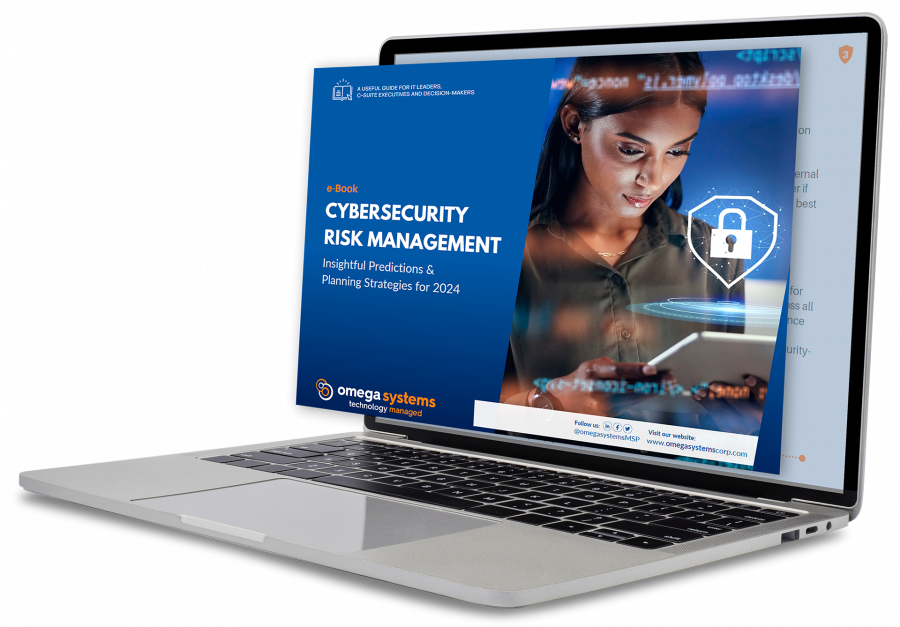
In the cat-and-mouse game of cybersecurity, staying ahead of every potential threat cannot be overstated. One critical challenge organizations face is the threat posed by end-of-life (EOL) or end-of-support lifecycles for software and hardware.
In this blog post, we’ll delve into the risks associated with EOL products, drawing insights from recent trends discussed in Omega Systems’ quarterly Cyber Threat update. During this on-demand webinar, Rick Mutzel, Omega’s head of security and technology, and Kaleigh Alessandro, Omega’s marketing director, shed light on the security and compliance implications of EOL software and shared strategies to safeguard against the cyber threats they pose.
What is End-of-Life Software?
In the fast-paced world of technology, software inevitably reaches the end of its lifecycle. This phenomenon, known as end of life (EOL), brings with it a host of security risks that businesses cannot afford to ignore. As Mutzel pointed out during the webinar, “When a piece of software reaches its end of life, it’s akin to closing the door on future protections. Security patches, bug fixes, and updates become relics of the past, leaving systems vulnerable to emerging threats.” Examples of widely used software that have met this fate in recent years include Windows 7 and older versions of Internet Explorer.
The risks of EOL software extend beyond corporate environments to home machines as well. Alessandro notes, “How many home machines are running some of these older applications or operating systems? And if they’re trying to access corporate information, there’s probably a lot of software and systems that are getting overlooked.”
End-of-Life Security Risks
In the fast-paced world of technology, software inevitably reaches the end of its lifecycle. This phenomenon, known as end of life (EOL), brings with it a host of security risks that businesses cannot afford to ignore. As Mutzel pointed out during the webinar, “When a piece of software reaches its end of life, it’s akin to closing the door on future protections. Security patches, bug fixes, and updates become relics of the past, leaving systems vulnerable to emerging threats.” Examples of widely used software that have met this fate in recent years include Windows 7 and older versions of Internet Explorer.
The risks of EOL software extend beyond corporate environments to home machines as well. Alessandro notes, “How many home machines are running some of these older applications or operating systems? And if they’re trying to access corporate information, there’s probably a lot of software and systems that are getting overlooked.”
Vulnerabilities
End-of-life software becomes a breeding ground for security vulnerabilities. Hackers actively seek out and exploit weaknesses that are no longer addressed by security updates, leaving businesses exposed to a myriad of potential threats.
Lack of Updates
The absence of regular updates is a glaring issue. Security patches are crucial in fortifying software against emerging threats. Without these updates, businesses are essentially leaving their digital doors wide open to cybercriminals.
Compliance Issues
Regulatory requirements demand up-to-date and secure systems, placing companies using EOL software at a heightened risk of failing to meet these standards and facing the associated repercussions. Failure to comply with industry standards and regulations can lead to legal issues, fines, and damage to a company’s reputation.
Real-World Consequences
Numerous high-profile security breaches serve as stark reminders of the real-world consequences of using EOL software. From sensitive data leaks to operational disruptions, the fallout from these incidents can be financially and reputationally devastating.
END-OF-LIFE SECURITY: THE WANNACRY EXAMPLE
The WannaCry ransomware attack in 2017 serves as a poignant example of the risks associated with EOL software. Exploiting the EternalBlue vulnerability, threat actors targeted Windows XP machines, taking advantage of Microsoft’s decision to end support for the operating system. Mutzel, reflecting on this incident in the recent Cyber Threat update, notes, “There was no way to remediate the ongoing issue, and that’s always a risk when dealing with end-of-life vulnerabilities.”
WannaCry is not an isolated case. Recent years have witnessed similar challenges with the end of support for Windows Server 2012 and Internet Explorer and with no-longer-supported products from the likes of Citrix and VMware. Mutzel emphasizes, “If you’re not keeping up with software agreements and applying current updates, you’re susceptible to exploits and vulnerabilities.”
EOL Software Mitigation Strategies for Businesses
To mitigate the risks associated with end-of-life software, businesses must adopt proactive vulnerability management strategies. Careful planning is key to avoiding the challenge of replacing all systems simultaneously, considering potential budgetary and labor implications.
- Maintain Comprehensive IT Asset Inventories. Regularly update and maintain inventories of your organization’s assets. Track end-of-life dates to anticipate and plan for necessary upgrades.
- Implement Robust Lifecycle Management Policies. Establish comprehensive lifecycle management policies for both your software and hardware. Align budgeting cycles with end-of-life projections to avoid expensive, large-scale replacements.
- Perform Routine Vulnerability Scanning. Conduct regular internal and external vulnerability scans to identify potential security risks. Prioritize remediation efforts based on the severity of vulnerabilities.
- Create Mitigation Policies for Irreplaceable Systems. Develop and implement mitigation policies for systems that cannot be immediately replaced. Segment networks, limit external access, and control ports and services to reduce exposure.
- Consider a Holistic Approach to EOL Technology. Partner with a reliable Managed Security Service Provider (MSSP) for a comprehensive strategy to manage your organization’s attack surface. Leverage the expertise of proven security professionals to address vulnerabilities not only at the software level but also for devices used both within and outside corporate settings.
A FUTURE-PROOF APPROACH TO CYBERSECURITY
The time is ripe to assess the integrity of your existing hardware and software infrastructure. The risks associated with end-of-life software – vulnerabilities, compliance issues, security breaches, and many more – are too significant to overlook. As technology marches forward, so too must your organization’s commitment to cybersecurity.
At Omega Systems, we offer comprehensive security solutions that seamlessly integrate hardware and software modernization to ensure your organization stands resilient against evolving cyber threats. Partner with us to elevate your overall security posture and navigate digital transformation with confidence. Connect with our security professionals to explore a cost-efficient strategy that will help you evolve into a security-forward organization in 2024 and beyond.
Categories: Information Technology Services, Managed Security Services, Managed Service Provider, MSP Blogs, Solution Blogs




